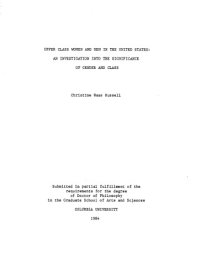
Ebook: Upper class women and men in the United States : an investigation into the significance of gender and class
Author: Christine Haas Russell
- Genre: Other Social Sciences
- Tags: Social classes -- United States, Upper class -- United States, Social classes, Upper class, United States
- Year: 1988
- Publisher: Columbia University
- City: New York
- Language: English
- pdf
This study concerns itself with the influence of two key determinants of stratification in the United States--class and gender-- on the roles, activities, and attitudes of its sample upper class members, giving particular attention to responding upper class women. Spheres of investigation include demographics, domestic division of labor, paid and volunteer work, and relationship to wealth. It was this study's purpose not only to provide a description of sample members' class- and gender-related roles, activities, and attitudes in these spheres, but also, based on these findings, to suggest their possible bases and implications. Beyond these principal aims, a further purpose of the study was to investigate, in relation to the interview sample, the relevance of certain existing sex-role theories and portrayals of upper class women.
The principal conclusion drawn from this research is that, despite sample upper class women's and men's overall parity in wealth-based power potential, the women, nevertheless, appeared to remain in a male-subordinate position within their class. This was reflected in findings that, relative to the men, responding women were characterized by a greater domestic identification, a weaker connection to the productive domain, more restricted access to top positions in the corporate and non-profit or charitable sectors, and less active management of their wealth. The theoretical framework suggested as best equipped to explain this apparent status inconsistency among sample upper class women is that which utilizes a class-based analysis.
The principal conclusion drawn from this research is that, despite sample upper class women's and men's overall parity in wealth-based power potential, the women, nevertheless, appeared to remain in a male-subordinate position within their class. This was reflected in findings that, relative to the men, responding women were characterized by a greater domestic identification, a weaker connection to the productive domain, more restricted access to top positions in the corporate and non-profit or charitable sectors, and less active management of their wealth. The theoretical framework suggested as best equipped to explain this apparent status inconsistency among sample upper class women is that which utilizes a class-based analysis.
Download the book Upper class women and men in the United States : an investigation into the significance of gender and class for free or read online
Continue reading on any device:

Last viewed books
Related books
{related-news}
Comments (0)